A Detailed Report on Technology and Business Operations Management
VerifiedAdded on 2021/11/22
|9
|2715
|92
Report
AI Summary
This report analyzes the crucial role of technology in modern business operations. It explores the application of technology in manufacturing, including the use of robotics, the Internet of Things (IoT), and cloud technology, highlighting how these innovations enhance efficiency, improve quality, and speed up production processes. The report delves into how technology investment decisions are made, considering factors like product variety, volume, and the balance between cost and flexibility. It also addresses the challenges organizations face when adopting new technologies, such as the need for adequate staff training, data monitoring, and aligning new systems with existing processes. Overall, the report emphasizes the transformative impact of technology on business, from enhancing manufacturing processes to addressing critical adoption challenges.
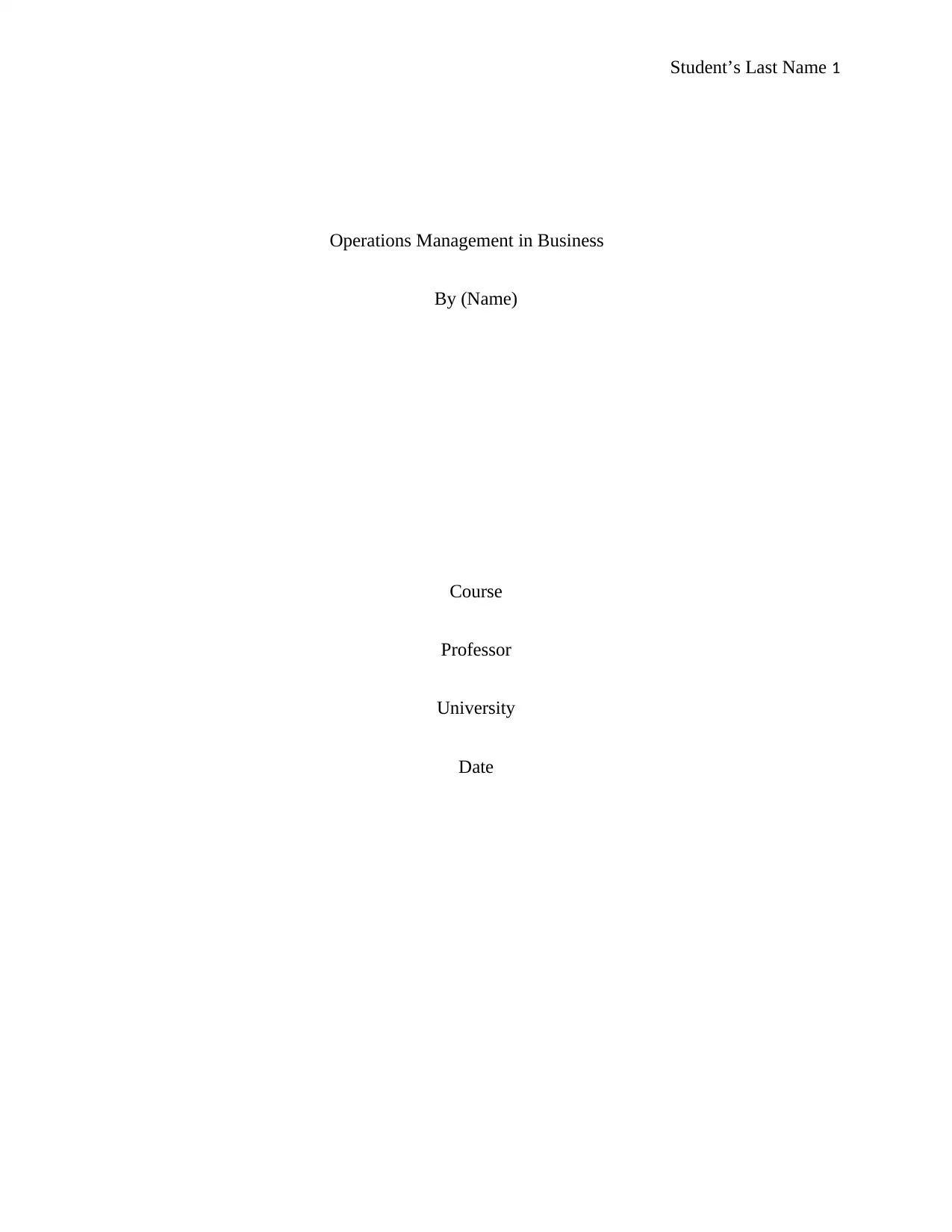
Student’s Last Name 1
Operations Management in Business
By (Name)
Course
Professor
University
Date
Operations Management in Business
By (Name)
Course
Professor
University
Date
Paraphrase This Document
Need a fresh take? Get an instant paraphrase of this document with our AI Paraphraser
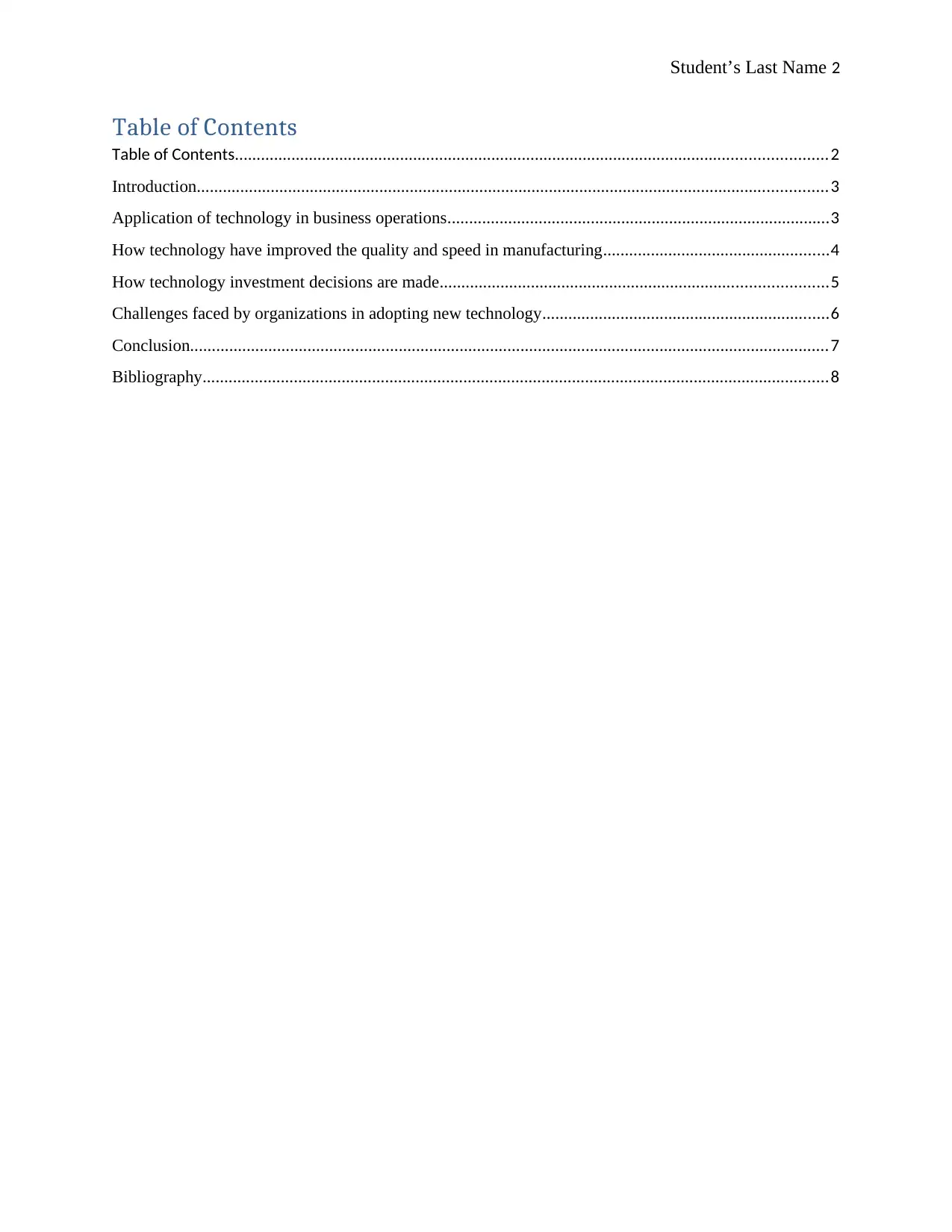
Student’s Last Name 2
Table of Contents
Table of Contents........................................................................................................................................2
Introduction.................................................................................................................................................3
Application of technology in business operations........................................................................................3
How technology have improved the quality and speed in manufacturing....................................................4
How technology investment decisions are made.........................................................................................5
Challenges faced by organizations in adopting new technology..................................................................6
Conclusion...................................................................................................................................................7
Bibliography................................................................................................................................................8
Table of Contents
Table of Contents........................................................................................................................................2
Introduction.................................................................................................................................................3
Application of technology in business operations........................................................................................3
How technology have improved the quality and speed in manufacturing....................................................4
How technology investment decisions are made.........................................................................................5
Challenges faced by organizations in adopting new technology..................................................................6
Conclusion...................................................................................................................................................7
Bibliography................................................................................................................................................8
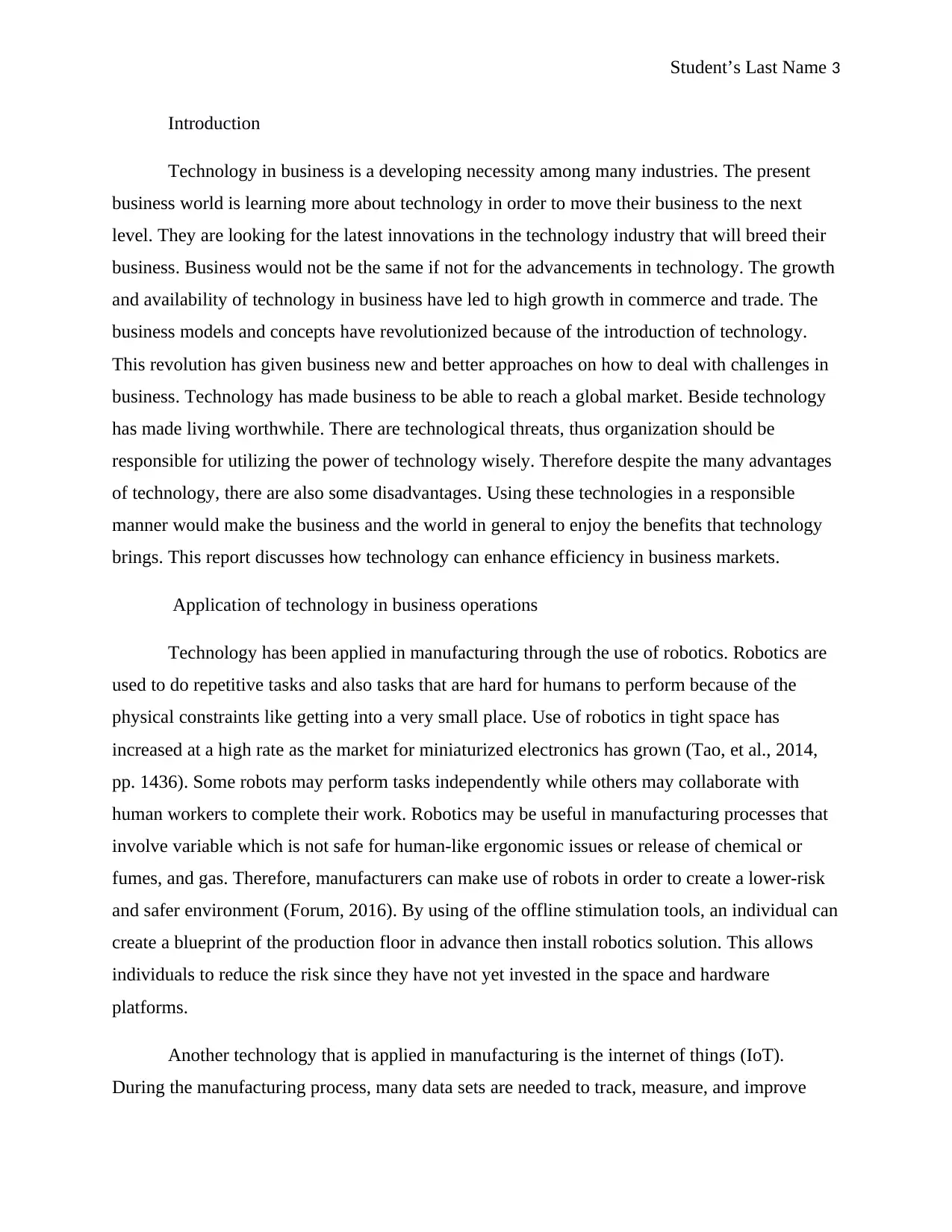
Student’s Last Name 3
Introduction
Technology in business is a developing necessity among many industries. The present
business world is learning more about technology in order to move their business to the next
level. They are looking for the latest innovations in the technology industry that will breed their
business. Business would not be the same if not for the advancements in technology. The growth
and availability of technology in business have led to high growth in commerce and trade. The
business models and concepts have revolutionized because of the introduction of technology.
This revolution has given business new and better approaches on how to deal with challenges in
business. Technology has made business to be able to reach a global market. Beside technology
has made living worthwhile. There are technological threats, thus organization should be
responsible for utilizing the power of technology wisely. Therefore despite the many advantages
of technology, there are also some disadvantages. Using these technologies in a responsible
manner would make the business and the world in general to enjoy the benefits that technology
brings. This report discusses how technology can enhance efficiency in business markets.
Application of technology in business operations
Technology has been applied in manufacturing through the use of robotics. Robotics are
used to do repetitive tasks and also tasks that are hard for humans to perform because of the
physical constraints like getting into a very small place. Use of robotics in tight space has
increased at a high rate as the market for miniaturized electronics has grown (Tao, et al., 2014,
pp. 1436). Some robots may perform tasks independently while others may collaborate with
human workers to complete their work. Robotics may be useful in manufacturing processes that
involve variable which is not safe for human-like ergonomic issues or release of chemical or
fumes, and gas. Therefore, manufacturers can make use of robots in order to create a lower-risk
and safer environment (Forum, 2016). By using of the offline stimulation tools, an individual can
create a blueprint of the production floor in advance then install robotics solution. This allows
individuals to reduce the risk since they have not yet invested in the space and hardware
platforms.
Another technology that is applied in manufacturing is the internet of things (IoT).
During the manufacturing process, many data sets are needed to track, measure, and improve
Introduction
Technology in business is a developing necessity among many industries. The present
business world is learning more about technology in order to move their business to the next
level. They are looking for the latest innovations in the technology industry that will breed their
business. Business would not be the same if not for the advancements in technology. The growth
and availability of technology in business have led to high growth in commerce and trade. The
business models and concepts have revolutionized because of the introduction of technology.
This revolution has given business new and better approaches on how to deal with challenges in
business. Technology has made business to be able to reach a global market. Beside technology
has made living worthwhile. There are technological threats, thus organization should be
responsible for utilizing the power of technology wisely. Therefore despite the many advantages
of technology, there are also some disadvantages. Using these technologies in a responsible
manner would make the business and the world in general to enjoy the benefits that technology
brings. This report discusses how technology can enhance efficiency in business markets.
Application of technology in business operations
Technology has been applied in manufacturing through the use of robotics. Robotics are
used to do repetitive tasks and also tasks that are hard for humans to perform because of the
physical constraints like getting into a very small place. Use of robotics in tight space has
increased at a high rate as the market for miniaturized electronics has grown (Tao, et al., 2014,
pp. 1436). Some robots may perform tasks independently while others may collaborate with
human workers to complete their work. Robotics may be useful in manufacturing processes that
involve variable which is not safe for human-like ergonomic issues or release of chemical or
fumes, and gas. Therefore, manufacturers can make use of robots in order to create a lower-risk
and safer environment (Forum, 2016). By using of the offline stimulation tools, an individual can
create a blueprint of the production floor in advance then install robotics solution. This allows
individuals to reduce the risk since they have not yet invested in the space and hardware
platforms.
Another technology that is applied in manufacturing is the internet of things (IoT).
During the manufacturing process, many data sets are needed to track, measure, and improve
⊘ This is a preview!⊘
Do you want full access?
Subscribe today to unlock all pages.

Trusted by 1+ million students worldwide
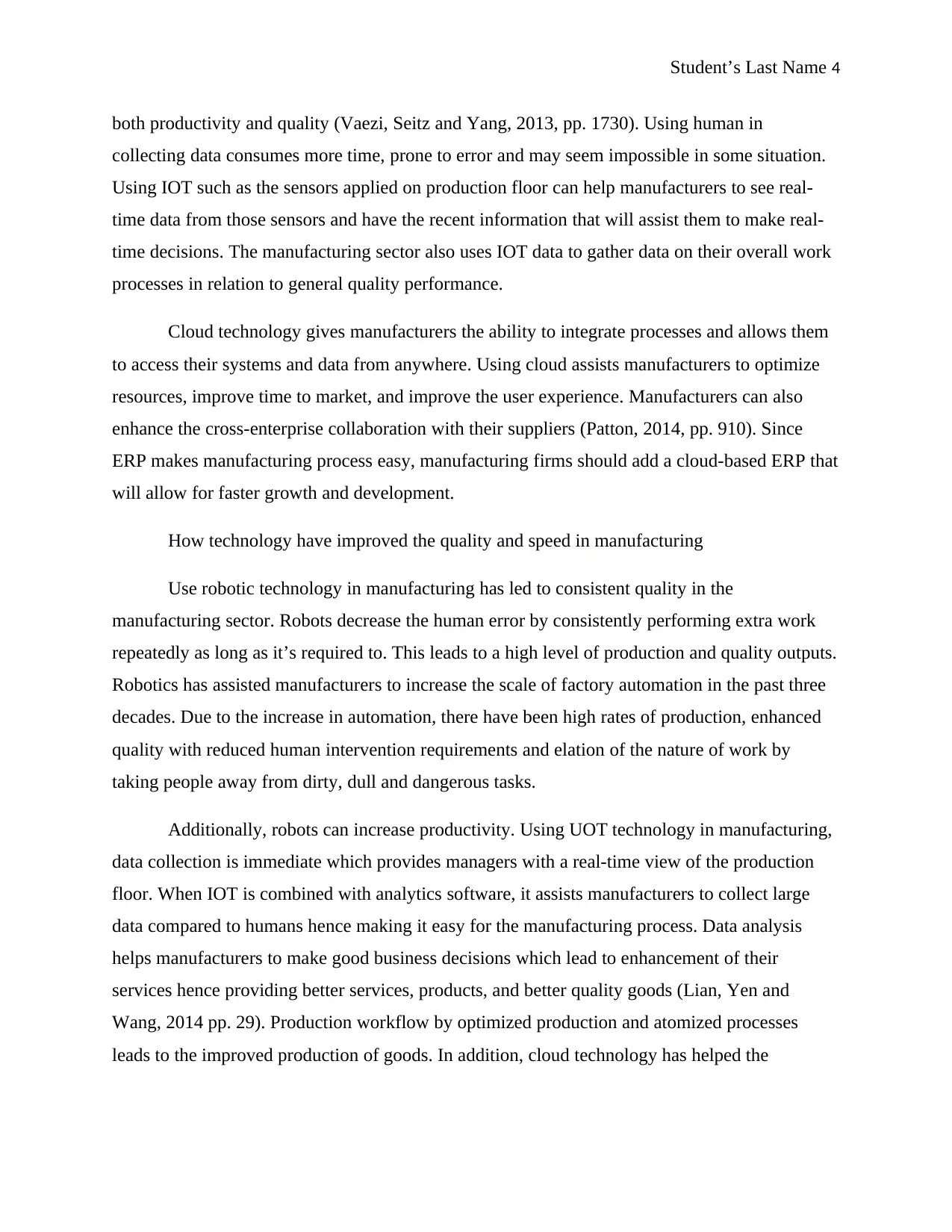
Student’s Last Name 4
both productivity and quality (Vaezi, Seitz and Yang, 2013, pp. 1730). Using human in
collecting data consumes more time, prone to error and may seem impossible in some situation.
Using IOT such as the sensors applied on production floor can help manufacturers to see real-
time data from those sensors and have the recent information that will assist them to make real-
time decisions. The manufacturing sector also uses IOT data to gather data on their overall work
processes in relation to general quality performance.
Cloud technology gives manufacturers the ability to integrate processes and allows them
to access their systems and data from anywhere. Using cloud assists manufacturers to optimize
resources, improve time to market, and improve the user experience. Manufacturers can also
enhance the cross-enterprise collaboration with their suppliers (Patton, 2014, pp. 910). Since
ERP makes manufacturing process easy, manufacturing firms should add a cloud-based ERP that
will allow for faster growth and development.
How technology have improved the quality and speed in manufacturing
Use robotic technology in manufacturing has led to consistent quality in the
manufacturing sector. Robots decrease the human error by consistently performing extra work
repeatedly as long as it’s required to. This leads to a high level of production and quality outputs.
Robotics has assisted manufacturers to increase the scale of factory automation in the past three
decades. Due to the increase in automation, there have been high rates of production, enhanced
quality with reduced human intervention requirements and elation of the nature of work by
taking people away from dirty, dull and dangerous tasks.
Additionally, robots can increase productivity. Using UOT technology in manufacturing,
data collection is immediate which provides managers with a real-time view of the production
floor. When IOT is combined with analytics software, it assists manufacturers to collect large
data compared to humans hence making it easy for the manufacturing process. Data analysis
helps manufacturers to make good business decisions which lead to enhancement of their
services hence providing better services, products, and better quality goods (Lian, Yen and
Wang, 2014 pp. 29). Production workflow by optimized production and atomized processes
leads to the improved production of goods. In addition, cloud technology has helped the
both productivity and quality (Vaezi, Seitz and Yang, 2013, pp. 1730). Using human in
collecting data consumes more time, prone to error and may seem impossible in some situation.
Using IOT such as the sensors applied on production floor can help manufacturers to see real-
time data from those sensors and have the recent information that will assist them to make real-
time decisions. The manufacturing sector also uses IOT data to gather data on their overall work
processes in relation to general quality performance.
Cloud technology gives manufacturers the ability to integrate processes and allows them
to access their systems and data from anywhere. Using cloud assists manufacturers to optimize
resources, improve time to market, and improve the user experience. Manufacturers can also
enhance the cross-enterprise collaboration with their suppliers (Patton, 2014, pp. 910). Since
ERP makes manufacturing process easy, manufacturing firms should add a cloud-based ERP that
will allow for faster growth and development.
How technology have improved the quality and speed in manufacturing
Use robotic technology in manufacturing has led to consistent quality in the
manufacturing sector. Robots decrease the human error by consistently performing extra work
repeatedly as long as it’s required to. This leads to a high level of production and quality outputs.
Robotics has assisted manufacturers to increase the scale of factory automation in the past three
decades. Due to the increase in automation, there have been high rates of production, enhanced
quality with reduced human intervention requirements and elation of the nature of work by
taking people away from dirty, dull and dangerous tasks.
Additionally, robots can increase productivity. Using UOT technology in manufacturing,
data collection is immediate which provides managers with a real-time view of the production
floor. When IOT is combined with analytics software, it assists manufacturers to collect large
data compared to humans hence making it easy for the manufacturing process. Data analysis
helps manufacturers to make good business decisions which lead to enhancement of their
services hence providing better services, products, and better quality goods (Lian, Yen and
Wang, 2014 pp. 29). Production workflow by optimized production and atomized processes
leads to the improved production of goods. In addition, cloud technology has helped the
Paraphrase This Document
Need a fresh take? Get an instant paraphrase of this document with our AI Paraphraser
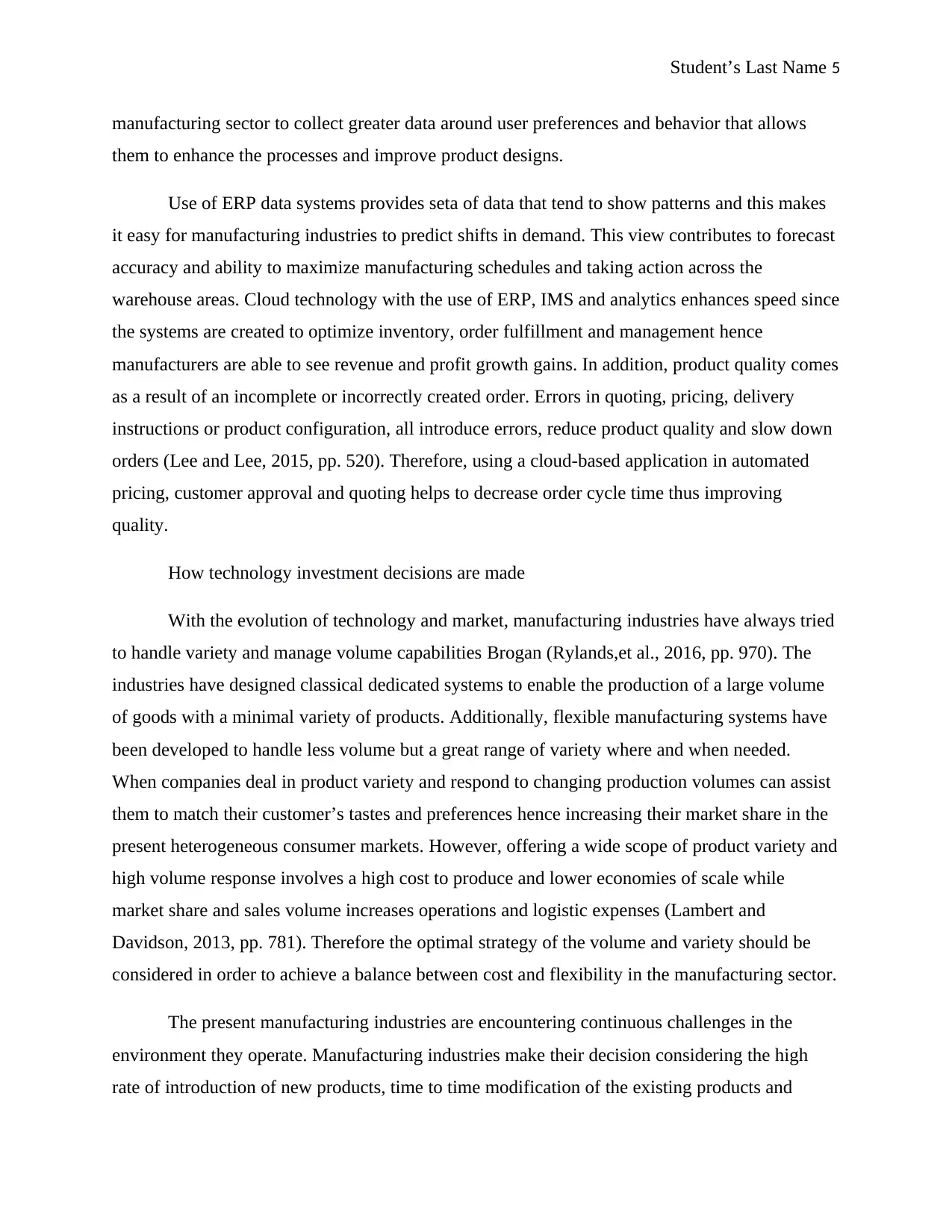
Student’s Last Name 5
manufacturing sector to collect greater data around user preferences and behavior that allows
them to enhance the processes and improve product designs.
Use of ERP data systems provides seta of data that tend to show patterns and this makes
it easy for manufacturing industries to predict shifts in demand. This view contributes to forecast
accuracy and ability to maximize manufacturing schedules and taking action across the
warehouse areas. Cloud technology with the use of ERP, IMS and analytics enhances speed since
the systems are created to optimize inventory, order fulfillment and management hence
manufacturers are able to see revenue and profit growth gains. In addition, product quality comes
as a result of an incomplete or incorrectly created order. Errors in quoting, pricing, delivery
instructions or product configuration, all introduce errors, reduce product quality and slow down
orders (Lee and Lee, 2015, pp. 520). Therefore, using a cloud-based application in automated
pricing, customer approval and quoting helps to decrease order cycle time thus improving
quality.
How technology investment decisions are made
With the evolution of technology and market, manufacturing industries have always tried
to handle variety and manage volume capabilities Brogan (Rylands,et al., 2016, pp. 970). The
industries have designed classical dedicated systems to enable the production of a large volume
of goods with a minimal variety of products. Additionally, flexible manufacturing systems have
been developed to handle less volume but a great range of variety where and when needed.
When companies deal in product variety and respond to changing production volumes can assist
them to match their customer’s tastes and preferences hence increasing their market share in the
present heterogeneous consumer markets. However, offering a wide scope of product variety and
high volume response involves a high cost to produce and lower economies of scale while
market share and sales volume increases operations and logistic expenses (Lambert and
Davidson, 2013, pp. 781). Therefore the optimal strategy of the volume and variety should be
considered in order to achieve a balance between cost and flexibility in the manufacturing sector.
The present manufacturing industries are encountering continuous challenges in the
environment they operate. Manufacturing industries make their decision considering the high
rate of introduction of new products, time to time modification of the existing products and
manufacturing sector to collect greater data around user preferences and behavior that allows
them to enhance the processes and improve product designs.
Use of ERP data systems provides seta of data that tend to show patterns and this makes
it easy for manufacturing industries to predict shifts in demand. This view contributes to forecast
accuracy and ability to maximize manufacturing schedules and taking action across the
warehouse areas. Cloud technology with the use of ERP, IMS and analytics enhances speed since
the systems are created to optimize inventory, order fulfillment and management hence
manufacturers are able to see revenue and profit growth gains. In addition, product quality comes
as a result of an incomplete or incorrectly created order. Errors in quoting, pricing, delivery
instructions or product configuration, all introduce errors, reduce product quality and slow down
orders (Lee and Lee, 2015, pp. 520). Therefore, using a cloud-based application in automated
pricing, customer approval and quoting helps to decrease order cycle time thus improving
quality.
How technology investment decisions are made
With the evolution of technology and market, manufacturing industries have always tried
to handle variety and manage volume capabilities Brogan (Rylands,et al., 2016, pp. 970). The
industries have designed classical dedicated systems to enable the production of a large volume
of goods with a minimal variety of products. Additionally, flexible manufacturing systems have
been developed to handle less volume but a great range of variety where and when needed.
When companies deal in product variety and respond to changing production volumes can assist
them to match their customer’s tastes and preferences hence increasing their market share in the
present heterogeneous consumer markets. However, offering a wide scope of product variety and
high volume response involves a high cost to produce and lower economies of scale while
market share and sales volume increases operations and logistic expenses (Lambert and
Davidson, 2013, pp. 781). Therefore the optimal strategy of the volume and variety should be
considered in order to achieve a balance between cost and flexibility in the manufacturing sector.
The present manufacturing industries are encountering continuous challenges in the
environment they operate. Manufacturing industries make their decision considering the high
rate of introduction of new products, time to time modification of the existing products and
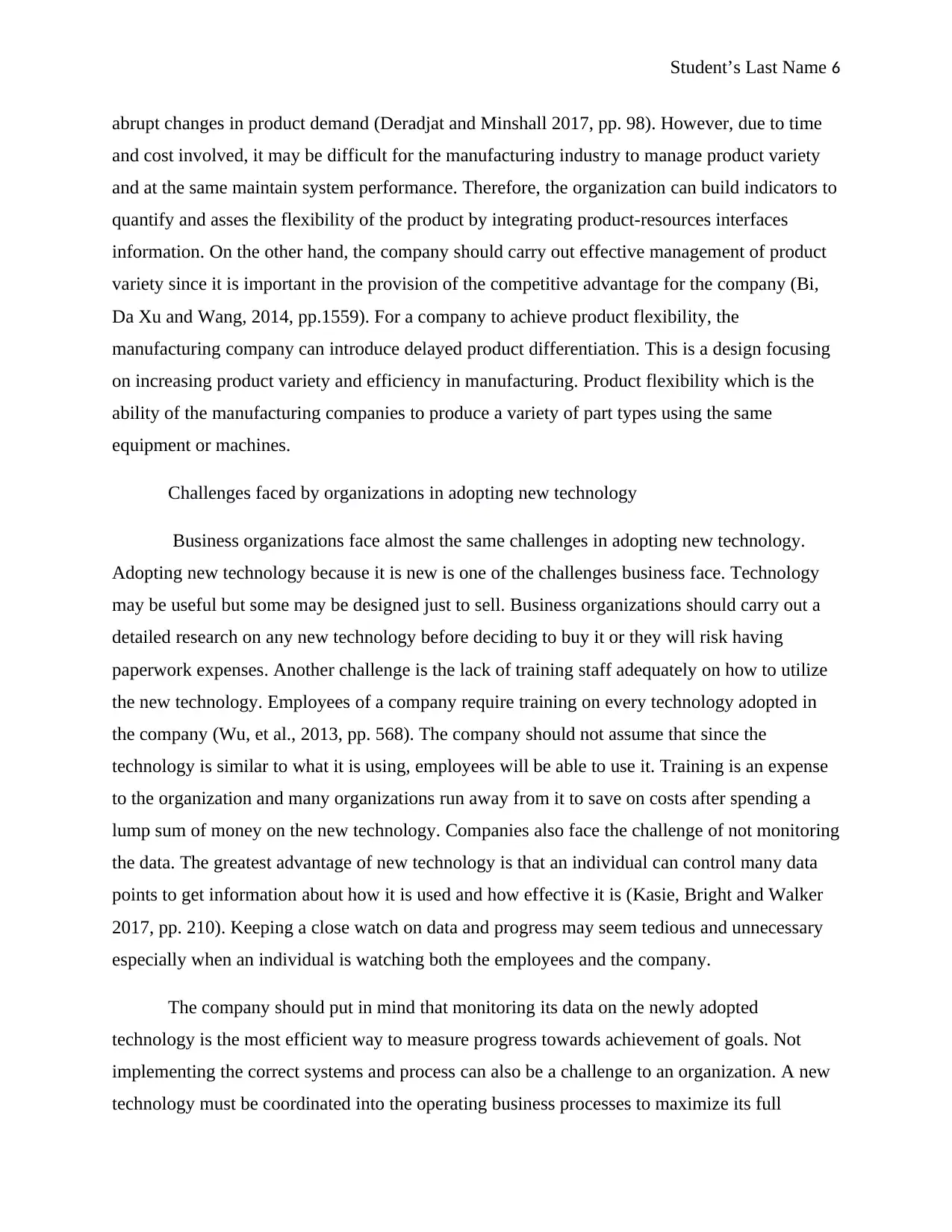
Student’s Last Name 6
abrupt changes in product demand (Deradjat and Minshall 2017, pp. 98). However, due to time
and cost involved, it may be difficult for the manufacturing industry to manage product variety
and at the same maintain system performance. Therefore, the organization can build indicators to
quantify and asses the flexibility of the product by integrating product-resources interfaces
information. On the other hand, the company should carry out effective management of product
variety since it is important in the provision of the competitive advantage for the company (Bi,
Da Xu and Wang, 2014, pp.1559). For a company to achieve product flexibility, the
manufacturing company can introduce delayed product differentiation. This is a design focusing
on increasing product variety and efficiency in manufacturing. Product flexibility which is the
ability of the manufacturing companies to produce a variety of part types using the same
equipment or machines.
Challenges faced by organizations in adopting new technology
Business organizations face almost the same challenges in adopting new technology.
Adopting new technology because it is new is one of the challenges business face. Technology
may be useful but some may be designed just to sell. Business organizations should carry out a
detailed research on any new technology before deciding to buy it or they will risk having
paperwork expenses. Another challenge is the lack of training staff adequately on how to utilize
the new technology. Employees of a company require training on every technology adopted in
the company (Wu, et al., 2013, pp. 568). The company should not assume that since the
technology is similar to what it is using, employees will be able to use it. Training is an expense
to the organization and many organizations run away from it to save on costs after spending a
lump sum of money on the new technology. Companies also face the challenge of not monitoring
the data. The greatest advantage of new technology is that an individual can control many data
points to get information about how it is used and how effective it is (Kasie, Bright and Walker
2017, pp. 210). Keeping a close watch on data and progress may seem tedious and unnecessary
especially when an individual is watching both the employees and the company.
The company should put in mind that monitoring its data on the newly adopted
technology is the most efficient way to measure progress towards achievement of goals. Not
implementing the correct systems and process can also be a challenge to an organization. A new
technology must be coordinated into the operating business processes to maximize its full
abrupt changes in product demand (Deradjat and Minshall 2017, pp. 98). However, due to time
and cost involved, it may be difficult for the manufacturing industry to manage product variety
and at the same maintain system performance. Therefore, the organization can build indicators to
quantify and asses the flexibility of the product by integrating product-resources interfaces
information. On the other hand, the company should carry out effective management of product
variety since it is important in the provision of the competitive advantage for the company (Bi,
Da Xu and Wang, 2014, pp.1559). For a company to achieve product flexibility, the
manufacturing company can introduce delayed product differentiation. This is a design focusing
on increasing product variety and efficiency in manufacturing. Product flexibility which is the
ability of the manufacturing companies to produce a variety of part types using the same
equipment or machines.
Challenges faced by organizations in adopting new technology
Business organizations face almost the same challenges in adopting new technology.
Adopting new technology because it is new is one of the challenges business face. Technology
may be useful but some may be designed just to sell. Business organizations should carry out a
detailed research on any new technology before deciding to buy it or they will risk having
paperwork expenses. Another challenge is the lack of training staff adequately on how to utilize
the new technology. Employees of a company require training on every technology adopted in
the company (Wu, et al., 2013, pp. 568). The company should not assume that since the
technology is similar to what it is using, employees will be able to use it. Training is an expense
to the organization and many organizations run away from it to save on costs after spending a
lump sum of money on the new technology. Companies also face the challenge of not monitoring
the data. The greatest advantage of new technology is that an individual can control many data
points to get information about how it is used and how effective it is (Kasie, Bright and Walker
2017, pp. 210). Keeping a close watch on data and progress may seem tedious and unnecessary
especially when an individual is watching both the employees and the company.
The company should put in mind that monitoring its data on the newly adopted
technology is the most efficient way to measure progress towards achievement of goals. Not
implementing the correct systems and process can also be a challenge to an organization. A new
technology must be coordinated into the operating business processes to maximize its full
⊘ This is a preview!⊘
Do you want full access?
Subscribe today to unlock all pages.

Trusted by 1+ million students worldwide
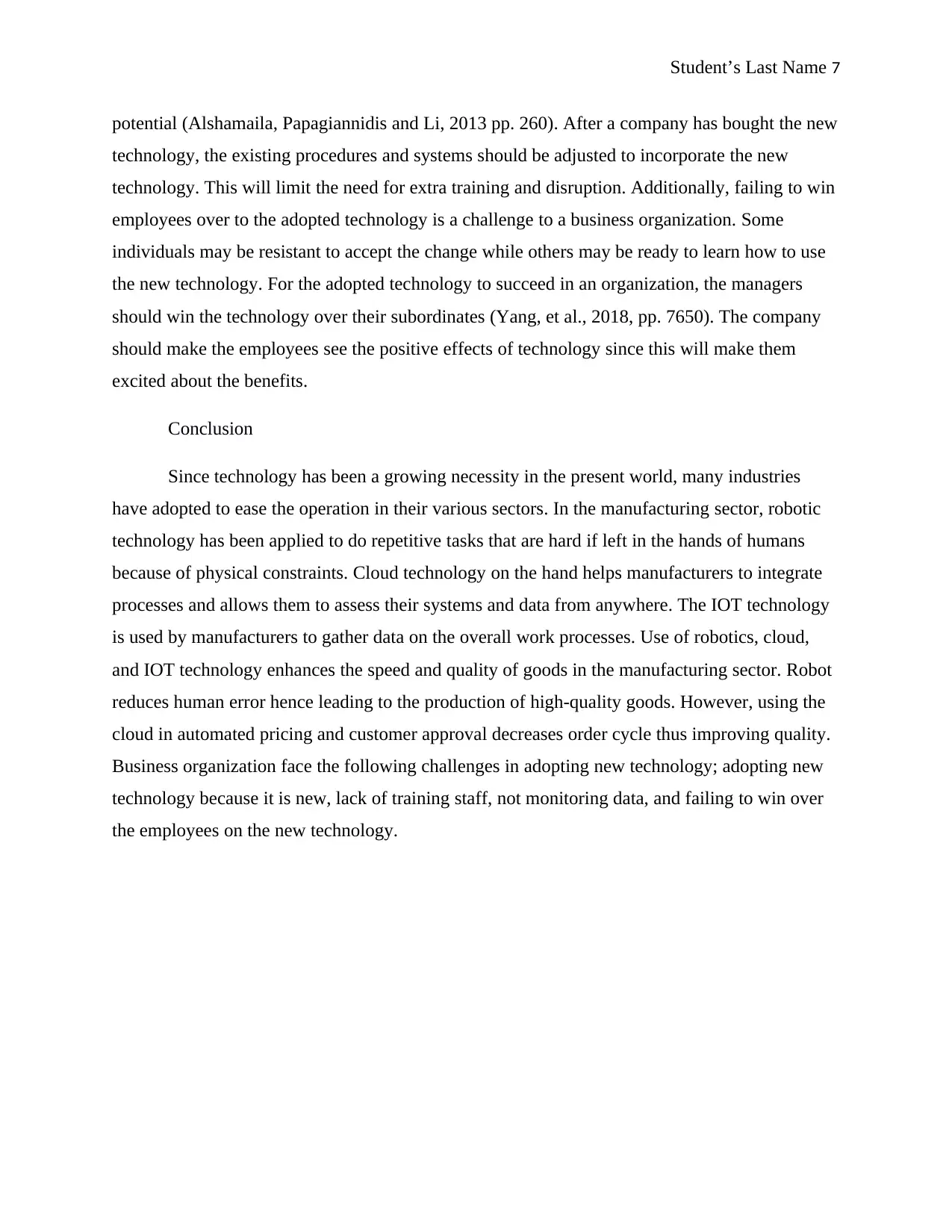
Student’s Last Name 7
potential (Alshamaila, Papagiannidis and Li, 2013 pp. 260). After a company has bought the new
technology, the existing procedures and systems should be adjusted to incorporate the new
technology. This will limit the need for extra training and disruption. Additionally, failing to win
employees over to the adopted technology is a challenge to a business organization. Some
individuals may be resistant to accept the change while others may be ready to learn how to use
the new technology. For the adopted technology to succeed in an organization, the managers
should win the technology over their subordinates (Yang, et al., 2018, pp. 7650). The company
should make the employees see the positive effects of technology since this will make them
excited about the benefits.
Conclusion
Since technology has been a growing necessity in the present world, many industries
have adopted to ease the operation in their various sectors. In the manufacturing sector, robotic
technology has been applied to do repetitive tasks that are hard if left in the hands of humans
because of physical constraints. Cloud technology on the hand helps manufacturers to integrate
processes and allows them to assess their systems and data from anywhere. The IOT technology
is used by manufacturers to gather data on the overall work processes. Use of robotics, cloud,
and IOT technology enhances the speed and quality of goods in the manufacturing sector. Robot
reduces human error hence leading to the production of high-quality goods. However, using the
cloud in automated pricing and customer approval decreases order cycle thus improving quality.
Business organization face the following challenges in adopting new technology; adopting new
technology because it is new, lack of training staff, not monitoring data, and failing to win over
the employees on the new technology.
potential (Alshamaila, Papagiannidis and Li, 2013 pp. 260). After a company has bought the new
technology, the existing procedures and systems should be adjusted to incorporate the new
technology. This will limit the need for extra training and disruption. Additionally, failing to win
employees over to the adopted technology is a challenge to a business organization. Some
individuals may be resistant to accept the change while others may be ready to learn how to use
the new technology. For the adopted technology to succeed in an organization, the managers
should win the technology over their subordinates (Yang, et al., 2018, pp. 7650). The company
should make the employees see the positive effects of technology since this will make them
excited about the benefits.
Conclusion
Since technology has been a growing necessity in the present world, many industries
have adopted to ease the operation in their various sectors. In the manufacturing sector, robotic
technology has been applied to do repetitive tasks that are hard if left in the hands of humans
because of physical constraints. Cloud technology on the hand helps manufacturers to integrate
processes and allows them to assess their systems and data from anywhere. The IOT technology
is used by manufacturers to gather data on the overall work processes. Use of robotics, cloud,
and IOT technology enhances the speed and quality of goods in the manufacturing sector. Robot
reduces human error hence leading to the production of high-quality goods. However, using the
cloud in automated pricing and customer approval decreases order cycle thus improving quality.
Business organization face the following challenges in adopting new technology; adopting new
technology because it is new, lack of training staff, not monitoring data, and failing to win over
the employees on the new technology.
Paraphrase This Document
Need a fresh take? Get an instant paraphrase of this document with our AI Paraphraser
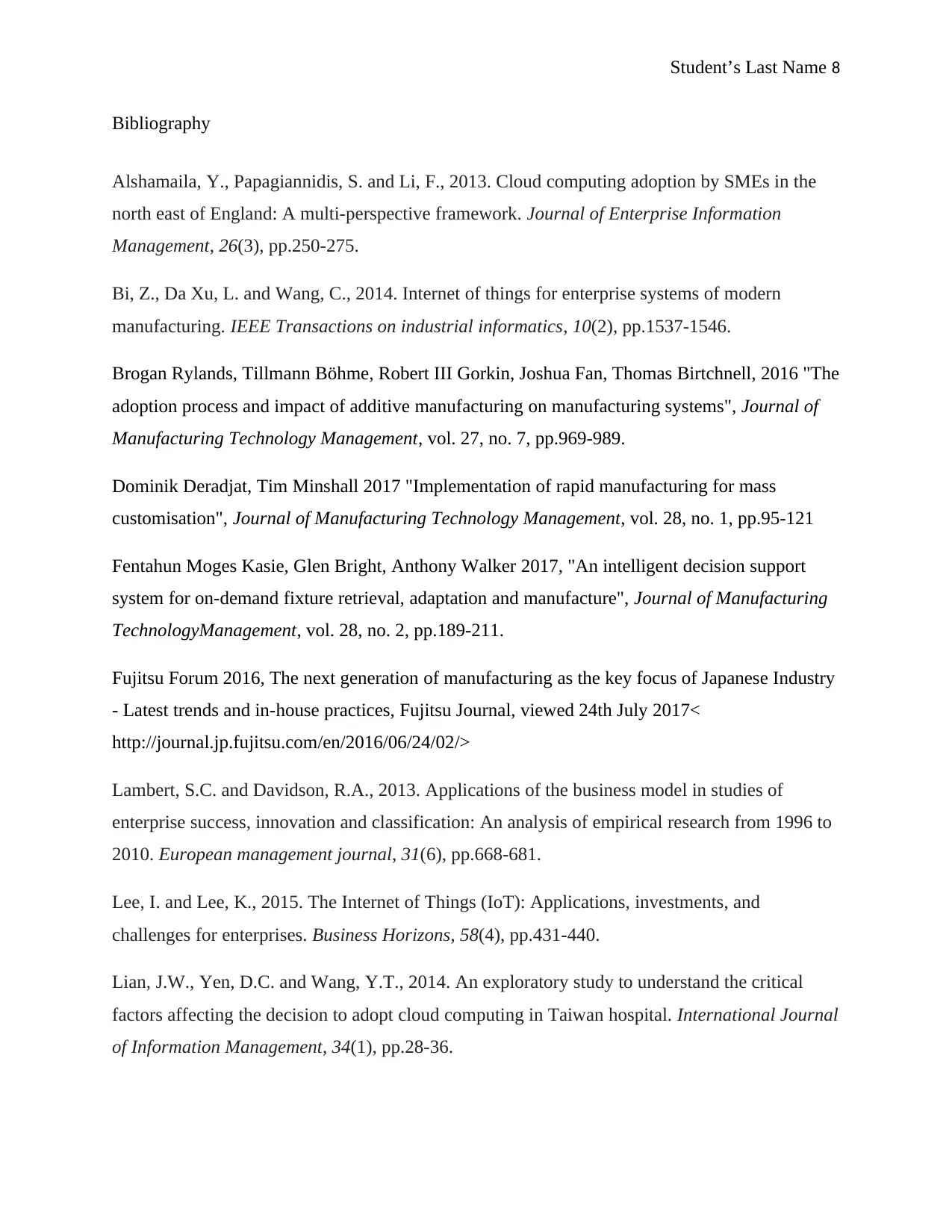
Student’s Last Name 8
Bibliography
Alshamaila, Y., Papagiannidis, S. and Li, F., 2013. Cloud computing adoption by SMEs in the
north east of England: A multi-perspective framework. Journal of Enterprise Information
Management, 26(3), pp.250-275.
Bi, Z., Da Xu, L. and Wang, C., 2014. Internet of things for enterprise systems of modern
manufacturing. IEEE Transactions on industrial informatics, 10(2), pp.1537-1546.
Brogan Rylands, Tillmann Böhme, Robert III Gorkin, Joshua Fan, Thomas Birtchnell, 2016 "The
adoption process and impact of additive manufacturing on manufacturing systems", Journal of
Manufacturing Technology Management, vol. 27, no. 7, pp.969-989.
Dominik Deradjat, Tim Minshall 2017 "Implementation of rapid manufacturing for mass
customisation", Journal of Manufacturing Technology Management, vol. 28, no. 1, pp.95-121
Fentahun Moges Kasie, Glen Bright, Anthony Walker 2017, "An intelligent decision support
system for on-demand fixture retrieval, adaptation and manufacture", Journal of Manufacturing
TechnologyManagement, vol. 28, no. 2, pp.189-211.
Fujitsu Forum 2016, The next generation of manufacturing as the key focus of Japanese Industry
- Latest trends and in-house practices, Fujitsu Journal, viewed 24th July 2017<
http://journal.jp.fujitsu.com/en/2016/06/24/02/>
Lambert, S.C. and Davidson, R.A., 2013. Applications of the business model in studies of
enterprise success, innovation and classification: An analysis of empirical research from 1996 to
2010. European management journal, 31(6), pp.668-681.
Lee, I. and Lee, K., 2015. The Internet of Things (IoT): Applications, investments, and
challenges for enterprises. Business Horizons, 58(4), pp.431-440.
Lian, J.W., Yen, D.C. and Wang, Y.T., 2014. An exploratory study to understand the critical
factors affecting the decision to adopt cloud computing in Taiwan hospital. International Journal
of Information Management, 34(1), pp.28-36.
Bibliography
Alshamaila, Y., Papagiannidis, S. and Li, F., 2013. Cloud computing adoption by SMEs in the
north east of England: A multi-perspective framework. Journal of Enterprise Information
Management, 26(3), pp.250-275.
Bi, Z., Da Xu, L. and Wang, C., 2014. Internet of things for enterprise systems of modern
manufacturing. IEEE Transactions on industrial informatics, 10(2), pp.1537-1546.
Brogan Rylands, Tillmann Böhme, Robert III Gorkin, Joshua Fan, Thomas Birtchnell, 2016 "The
adoption process and impact of additive manufacturing on manufacturing systems", Journal of
Manufacturing Technology Management, vol. 27, no. 7, pp.969-989.
Dominik Deradjat, Tim Minshall 2017 "Implementation of rapid manufacturing for mass
customisation", Journal of Manufacturing Technology Management, vol. 28, no. 1, pp.95-121
Fentahun Moges Kasie, Glen Bright, Anthony Walker 2017, "An intelligent decision support
system for on-demand fixture retrieval, adaptation and manufacture", Journal of Manufacturing
TechnologyManagement, vol. 28, no. 2, pp.189-211.
Fujitsu Forum 2016, The next generation of manufacturing as the key focus of Japanese Industry
- Latest trends and in-house practices, Fujitsu Journal, viewed 24th July 2017<
http://journal.jp.fujitsu.com/en/2016/06/24/02/>
Lambert, S.C. and Davidson, R.A., 2013. Applications of the business model in studies of
enterprise success, innovation and classification: An analysis of empirical research from 1996 to
2010. European management journal, 31(6), pp.668-681.
Lee, I. and Lee, K., 2015. The Internet of Things (IoT): Applications, investments, and
challenges for enterprises. Business Horizons, 58(4), pp.431-440.
Lian, J.W., Yen, D.C. and Wang, Y.T., 2014. An exploratory study to understand the critical
factors affecting the decision to adopt cloud computing in Taiwan hospital. International Journal
of Information Management, 34(1), pp.28-36.
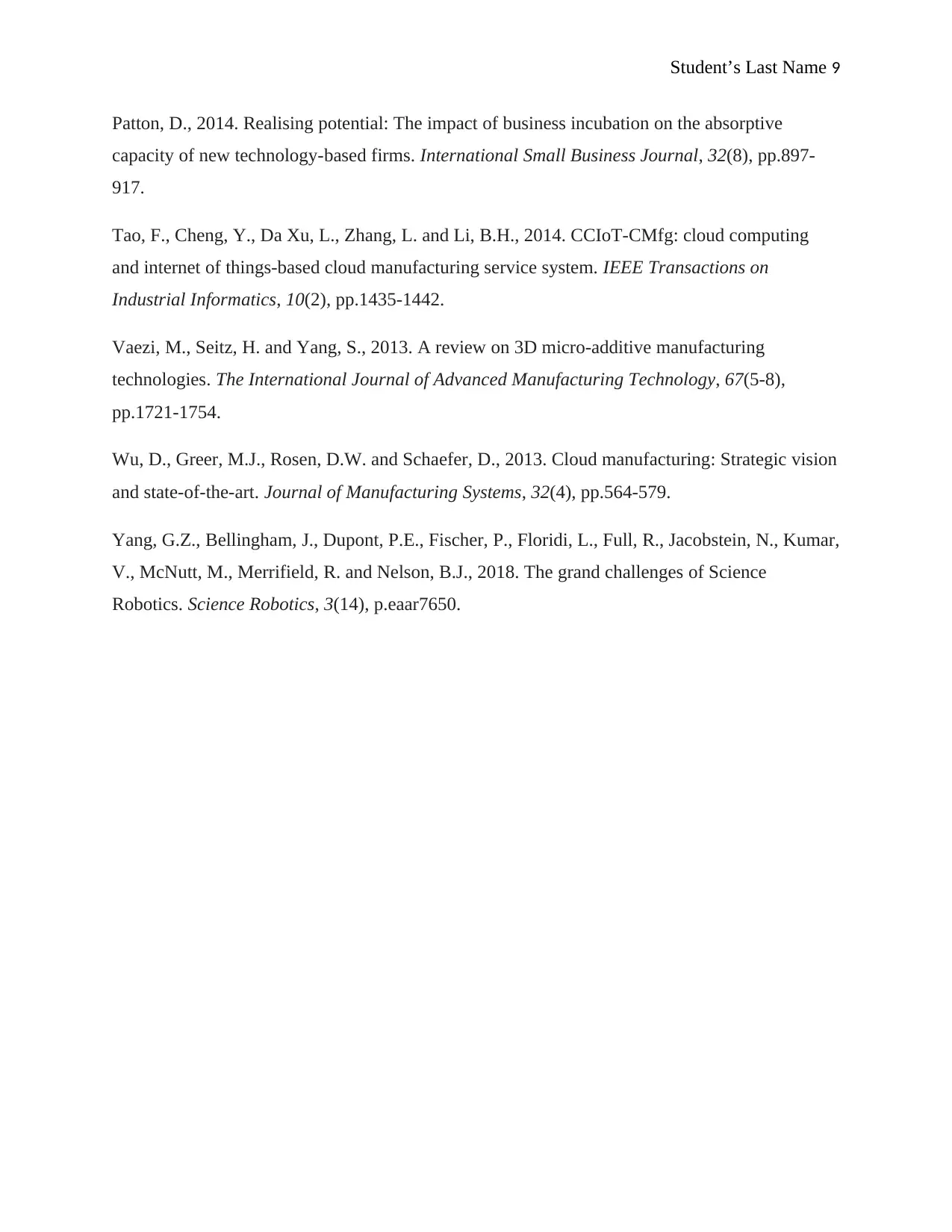
Student’s Last Name 9
Patton, D., 2014. Realising potential: The impact of business incubation on the absorptive
capacity of new technology-based firms. International Small Business Journal, 32(8), pp.897-
917.
Tao, F., Cheng, Y., Da Xu, L., Zhang, L. and Li, B.H., 2014. CCIoT-CMfg: cloud computing
and internet of things-based cloud manufacturing service system. IEEE Transactions on
Industrial Informatics, 10(2), pp.1435-1442.
Vaezi, M., Seitz, H. and Yang, S., 2013. A review on 3D micro-additive manufacturing
technologies. The International Journal of Advanced Manufacturing Technology, 67(5-8),
pp.1721-1754.
Wu, D., Greer, M.J., Rosen, D.W. and Schaefer, D., 2013. Cloud manufacturing: Strategic vision
and state-of-the-art. Journal of Manufacturing Systems, 32(4), pp.564-579.
Yang, G.Z., Bellingham, J., Dupont, P.E., Fischer, P., Floridi, L., Full, R., Jacobstein, N., Kumar,
V., McNutt, M., Merrifield, R. and Nelson, B.J., 2018. The grand challenges of Science
Robotics. Science Robotics, 3(14), p.eaar7650.
Patton, D., 2014. Realising potential: The impact of business incubation on the absorptive
capacity of new technology-based firms. International Small Business Journal, 32(8), pp.897-
917.
Tao, F., Cheng, Y., Da Xu, L., Zhang, L. and Li, B.H., 2014. CCIoT-CMfg: cloud computing
and internet of things-based cloud manufacturing service system. IEEE Transactions on
Industrial Informatics, 10(2), pp.1435-1442.
Vaezi, M., Seitz, H. and Yang, S., 2013. A review on 3D micro-additive manufacturing
technologies. The International Journal of Advanced Manufacturing Technology, 67(5-8),
pp.1721-1754.
Wu, D., Greer, M.J., Rosen, D.W. and Schaefer, D., 2013. Cloud manufacturing: Strategic vision
and state-of-the-art. Journal of Manufacturing Systems, 32(4), pp.564-579.
Yang, G.Z., Bellingham, J., Dupont, P.E., Fischer, P., Floridi, L., Full, R., Jacobstein, N., Kumar,
V., McNutt, M., Merrifield, R. and Nelson, B.J., 2018. The grand challenges of Science
Robotics. Science Robotics, 3(14), p.eaar7650.
⊘ This is a preview!⊘
Do you want full access?
Subscribe today to unlock all pages.

Trusted by 1+ million students worldwide
1 out of 9
Related Documents
Your All-in-One AI-Powered Toolkit for Academic Success.
+13062052269
info@desklib.com
Available 24*7 on WhatsApp / Email
![[object Object]](/_next/static/media/star-bottom.7253800d.svg)
Unlock your academic potential
Copyright © 2020–2025 A2Z Services. All Rights Reserved. Developed and managed by ZUCOL.





